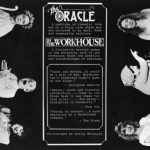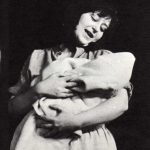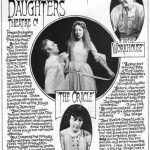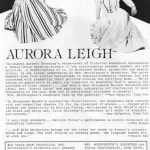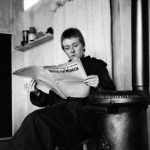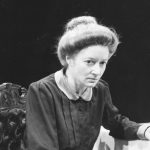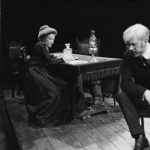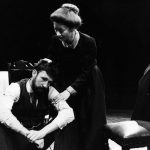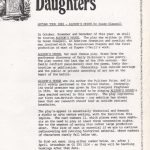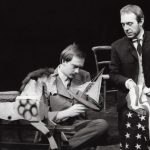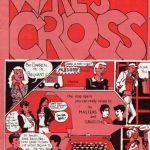Company name: Mrs Worthington’s Daughters
Founders: Stacey Charlesworth, Anne Engel, Julie Holledge, Stephen Ley, Maggie Wilkinson
Established: 1978
Reason: To produce plays by and about women of the past
Current Status: Disbanded 1982 due to loss of funding
Area of work: Women’s
Policy: To work for six months of each year, employing actors, directors, designers and stage management as required.
Structure: Production company
Based: London
Funding: Arts Council of Great Britain and Regional Arts
Performance venues: London: Lauderdale House, Kings Head, Old Half Moon, Young Vic Studio, Theatre Upstairs, and National tours to middle and small-scale venues.
Audiences: Wide range of people, of particular interest to women
For other company images see Anne Engel’s interviewee page.
Company work and process:
Mrs Worthington’s Daughters was formed in 1978 by Stacey Charlesworth, Anne Engel, Julie Holledge, Stephen Ley and Maggie Wilkinson. The women had previously run the Feminist Study Group – a kind of weekly consciousness raising group for women in theatre, where up to 30 women would regularly attend. They picketed West End theatre goers with leaflets asking: ‘Do you want to see women represented other than as men’s wives, mothers, lovers and daughters?’ and took their fight to Equity, which led to the formation of the women’s sub-committee. Julie Holledge had been extensively researching lost women’s suffrage plays for her PhD (later to become Innocent Flowers: Women in the Edwardian Theatre, published by Virago) and this gave them their idea of producing plays about and by women of the past.
‘In terms of process, we had all been casualties of terrible collectives. We took our scars and licked our wounds and talked a lot about how we wanted to have a theatre company: what we wanted to do, what would make us happy. We decided we would throw the rulebook out, the rulebook of collectives. We would be a production company and we would retain the power, and we would hire in actors, crew, directors, designers, as and when we needed them, and the company would have a mission to rediscover work, forgotten work, by women. And we had a wonderful time. We all got tickets to the Reading Room at the British Museum and we went and poured over the Lord Chancellor’s collection, sometimes opening parcels that hadn’t been touched.’ [They discovered over 500 women playwrights from the period 1900–1920.] ‘And we decided that it was based on friendship, that we wanted to work with people we wanted to work with, and that was the most important thing- apart from the mission of the company – it was actually the pleasure of working.’ (Anne Engel)
Their first production was a double bill of The Oracle by Susannah Cibber and In the Workhouse by Margaret Wynne Nevinson (1979), which later that year became a double bill of The Oracle with James Barrie’s The Twelve Pound Look. ‘When we started we did The Oracle at the Kings Head and Lauderdale House where we did it outdoors, in this kind of wonderful park setting. The play, by Susannah Cibber, attracted us because it was about a man becoming completely incapable… it was in contrast to Barrie’s early suffrage play, The Twelve Pound Look, which was a very strong piece. So we had a kind of frothy fantasy piece and then a sort of early women’s suffrage piece. Susannah Cibber was one of the first playwrights to earn her living through writing plays as well – she was an actress and a playwright – so that was very important.’ (Anne Engel)
In the Workhouse was a type of early Agit Prop, with a discussion between women in the maternity ward of a workhouse about the benefits and disadvantages of marriage. This was followed the same year by Michelene Wandor’s highly regarded adaptation of Elizabeth Barrett Browning’s verse-novel Aurora Leigh, where, ‘Victorian womanhood represented a female voice speaking acutely of the relationship between gender, art and politics.’ (Mrs Worthington’s Daughters publicity)
In the 1980s, they revived the lost classic Rutherford and Son by Githa Sowerby, looking at the hypocrisies of family life in England through the relationship between a Northern factory owner and his family. First staged by Harley Granville-Barker at the Royal Court Theatre in 1912, it had disappeared from sight before the company unearthed it. Next came Angels of War by Muriel Box (1982). Written in 1935, it was a popular anti-war drama of the Thirties about ambulance drivers on the Western Front in the Great War. Muriel Box was an Oscar-winning screenwriter and director. The company’s final show with director Julie Holledge and designer Mary Moore, was Alison’s House by American Susan Glaspell, written in 1930. It used Emily Dickinson’s posthumously discovered love poetry to create a fictionalised account of her life.
Mrs Worthington’s Daughters’ Daughters
‘Julie and Mary went off to Australia, and we decided we wanted to carry on in some way, but it wouldn’t be Mrs Worthington’s Daughters because Julie was a kind of lynchpin in that, so we formed Mrs Worthington’s Daughters Daughters in order to do Wyre’s Cross…and that was the most fun you could ever have.’ (Anne Engel)
Written by Peta Masters and Geraldine Griffiths, Wyre’s Cross was an amalgam of all the popular television soap operas. Comprising four episodes, it played at the Drill Hall lunchtimes and then was repeated evenings at the King’s Head, so that audiences could catch all the episodes. The company came up with the novel idea of getting sponsorship through writing and performing tailor-made live ads for the ‘commercial breaks.’ A number of high profile companies happily agreed to sponsoring the ads and the show. These included: Courage Best, Clairol Loving Care, Country Life butter, Mum Quickdry deodorant, She and The New Statesman – with verses written by satirist Roger Woddis. The live ads were a huge success and the whole venture proved highly popular, creating quite a cult following.
After Wyre’s Cross, the company applied for funding for a new show they were developing called Greece. Sadly their Arts Officer and key supporter Ruth Marks had died and their replacement officer had never seen, nor knew anything of the company’s work, and the application was turned down. After much soul searching, they agreed they were not prepared to continue without funding as this would feel like starting all over. (Open here for a more detailed account)
Personal appraisal and thoughts:
Julie Holledge: ‘…and because we were doing all that political work, Anne and Stacey and Maggie and I, eventually, we felt that we’d like to do something together and that’s really how Worthington’s started. And it started on the premise of plays by and about women from the past. And it was really because I’d been doing all the research and so that was the kick-off point when we started, saying ‘well, that’s a new angle’; and it’s something we really cared about because of that notion of trying to create our own tradition, our own history.’
Mary Moore: ‘I do remember being rung up by Julie Holledge and asked if I would – for no money – design their show? They hadn’t got any money, but they could promise me some nice food and she was very charming and I thought, ‘This is a very charming phone call.’ How could I say no?’.
Mary Moore: ‘By this time I think Julie and I had actually formed a language that was a sort of a grammar about design, and we realised that in this piece [Aurora Leigh] there was the inner and the outer. There had to be a sense of the outer space, which was of the social world of the time and where other people could come from, and then there was the inner world, her brother, her artistic inspiration – the place she would go for her thinking. So that was the spatial sense of it and it was very simple; it was just a black cloth outer area and a white floor that went up into a sort of a wave, a sense of a place, a landscape if you like, an inner landscape.’
Reviews:
The Oracle and In The Workhouse
‘Funny and moving. It would be a pity if Mrs Worthington’s Daughters hadn’t gone on the stage.’ (Islington Gazette)
‘Satire, charm and forceful indignation…Dash to the Kings head to see these two tiny plays…The Group’s enterprise is wonderful.’ (Time Out)
Aurora Leigh
‘In Michelene Wandor’s quicksilver dramatisation, the Daughters’ have created rich and compelling theatre fit for the classiest of stages…Played with candour and sensitivity by Marilyn Finlay, well-served by Mary Moore’s stylish black and white set, Julie Holledge’s production is a model of elegance.’ (Time Out)
‘A very high standard…Marilyn Finlay’s performance as Aurora contained an enchanting radiance.’ (The Stage)
‘…and this production brings out the other two women in Aurora’s triangle sharp and clear…The work retains an amazing power, the language shakes you even now.’ (Spare Rib)
Rutherford and Son
‘The company is proudly touring its discovery during May and June before it returns, appropriately, to the Royal Court. They say it’s the first professional production for over 50 years; if so, that’s their scoop and our loss. Why hasn’t it been done more often?’ (Manchester Guardian)
Wyre’s Cross
‘Things are really hotting up in ‘Wyre’s Cross’, the fictional backwater created by Mrs Worthington’s Daughters’ Daughters as the setting for their four-part soap opera. Image a hybrid of Coronation Street and The Archers, add a dash of piercing feminist wit and a strong satirical sauce and you’re nearly there. At a glance it’s a frivolous piece…but behind all the gaiety they drive home their points about female stereotyping and media manipulation…’ (Time Out)
‘Might turn out to be the longest running fringe show ever.’ (The Stage)
‘An absolute joy to watch.’ (The Times)
Productions:
Production Name Venues Dates
The Oracle
Writer: Susannah Cibber
In The Workhouse
Writer: Margaret Wynne Nevinson
Director: Julie Holledge
Cast: Stacey Charlesworth, Anne Engel, Stephen Ley, Maggie Wilkinson
Designer: Mary MooreKing's Head
Lauderdale House1979
The Oracle
Writer: Susannah Cibber
The Twelve Pound Look
Writer: James Barrie
Director: Julie Holledge
Cast: Stacey Charlesworth, Anne Engel, Stephen Ley, Maggie Wilkinson
Designer: Mary MooreOld Half Moon
National tour1979
Aurora Leigh adapted from Elizabeth Barrett Browning
by Michelene Wandor
Director: Julie Holledge
Cast: Stacey Charlesworth, Anne Engel, Marilyn Finlay, Stephen Ley, Maggie Wilkinson
Designer: Mary MooreYoung Vic Studio
National Tour1979
Rutherford and Son
Writer: Githa Sowerby
Director: Julie Holledge
Cast included: Stacey Charlesworth, Anne Engel, Stephen Ley, Maggie WilkinsonTheatre Upstairs
National Tour1980
Angels of War
Writer: Muriel Box
Director: Angela Langfield
Cast: Geraldine Griffiths, Peta Masters, Jill Stanford, Maggie Wilkinson, Cordelia Ditton,
Stacey Charlesworth, Erika Poole, Anne Engel,
Vivienne Moore
Designer: Sarah Pauley
Lighting Designer: Veronica WoodOld Half Moon
National tour1982
Alison's House
Writer: Susan Glaspell
Director: Julie Holledge
Cast included: Stacey Charlesworth, Anne Engel, Stephen Ley, Maggie Wilkinson1982
Wyre's Cross
Writers: Geraldine Griffiths and Peta Masters
Director: Angela Langfield
Cast: Keith Casburn, Stacey Charlesworth, Cordelia Ditton, Anne Engel, Geraldine Griffiths
Clive Mantle, Jo Masters, Karen Meagher, Vivienne Moore, Erika Poole, Jill Stanford, Paul Toner
Designer: Claudia Mayer
Musical Director: Jo MastersProduced by Mrs Worthington's Daughters' Daughters for Women Live
Drill Hall
Kings Head1982
Interviewee reference: Anne Engel, Julie Holledge, Mary Moore, Michelene Wandor
Existing archive material: Anne Engel
Bibliography:
Odd Woman Out by Muriel Box (Leslie Frewin 1974)
Innocent Flowers – Women in the Edwardian Theatre (Virago 1981)
Wyre’s Cross by Masters and Griffiths (30th Anniversary Edition 2012)
Acknowledgements: This page was written and constructed by Jessica Higgs, assisted by Kim Dexter, with grateful thanks to Anne Engel, Julie Holledge, Mary Moore and Michelene Wandor. November 2013
The creation of this page was supported by the National Lottery through the Heritage Lottery Fund.

